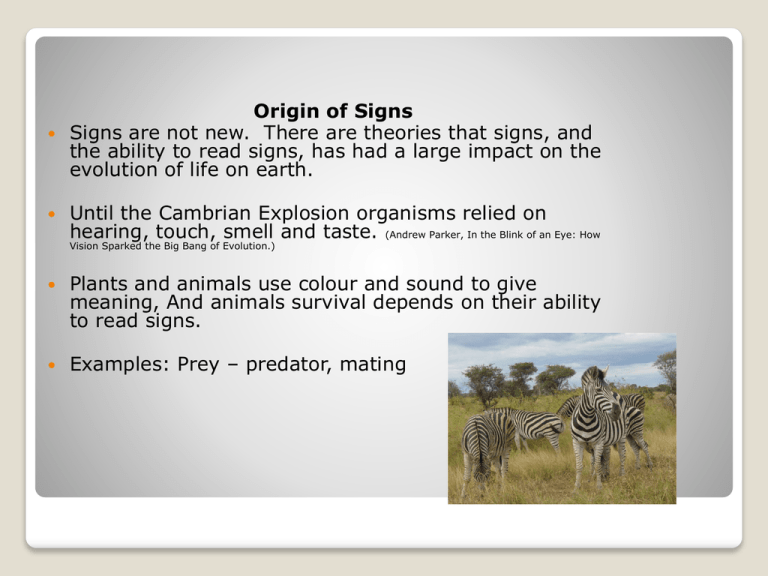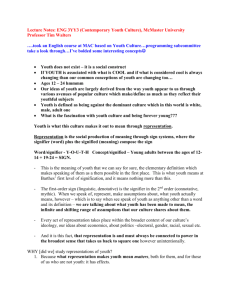Signs - abrams media
advertisement

Origin of Signs Signs are not new. There are theories that signs, and the ability to read signs, has had a large impact on the evolution of life on earth. Until the Cambrian Explosion organisms relied on hearing, touch, smell and taste. (Andrew Parker, In the Blink of an Eye: How Vision Sparked the Big Bang of Evolution.) Plants and animals use colour and sound to give meaning, And animals survival depends on their ability to read signs. Examples: Prey – predator, mating Biosemiotics (bios=life & semion=sign) is an interdisciplinary science that studies communication and signification in living systems. Communication is the essential characteristic of life. An organism is a message to future generations that specifies how to survive and reproduce. Any autocatalytic system transfers information (i.e. initial conditions) to its progeny so that daughter systems will eventually reach the same state as their parent. Biosemiotics Self-reproducing systems have a semantic closure because they define themselves in their progeny. A sign (defined in a broadest sense) is an object that is a part of some self-reproducing system. A sign is always useful for the system and its value can be determined by its contribution to the reproductive value of the entire system. The major trend in the evolution of signs is the increase of their complexity via development of new hierarchical levels, i.e., metasystem transitions biosemiotics Rearranging signifiers and signifieds •Signs can mean different things •Before mass media, the meaning of signs changed more slowly •Self-interested parties rearrange the relationships between signifier and signified •Advertising operates by splitting signifier and signified so that it can recombine a signifier from one meaning system with a signified from another. •This is how a distinctive -- and different -- new sign can be concocted for a brand product. •When signifiers can be made to take on many and various meanings, they are known as floating signifiers. ALREADYNESS "Ads create an 'alreadyness' of 'facts' about ourselves as individuals: that we are consumers, that we have certain values, that we will freely buy things, consume, on the basis of those values..." (Williamson, 1978:42). Advertisers mine the cultural lives of demographically segmented audiences for meanings to associate with their products, and then rearrange those meanings through the framework of the advertisement, thereby positioning viewers to complete commodity signs as if there were a natural, intrinsic association between the viewer's own meaning systems and the corporate products. Ads invite us to recognize ourselves as already the kind of people who are consonant with the particular commodity aesthetic being advertised. Colour The meanings of colours emerge from both environmental and historical factors •Human culture uses colour on self: clothes, jewels, feathers, paint, flowers, beads, hair tattoos, body Cultures differ from each other by the uses they make of colours and chromatic patterns. Colour, combined with pattern and style function as distinctive markers, or camouflage. This changes through history, so these uses of colour can be documented, as can the patterns and styles Color Marketing Group “Color sells, and the right color sells better” •Color increases brand recognition by up to 80 percent. •Color improves readership as much as 40 percent. •Color accelerates learning from 55 to 78 percent. •Color increases comprehension by 73 percent. •Color ads are read up to 42 percent more than similar ads in black and white. •Color can be up to 85 percent of the reason people decide to buy. CADILLAC "The 2004 Cadillac XLR Neiman Marcus Limited Edition XLR, produced in the exclusive color 'Majestic Amethyst‘ retailed for $85,000 through the 2003Neiman Marcus Christmas catalog. It sold out in just 14 minutes."The ChromaFlair colors "Titanium"used on the 2006/2007 Cadillac DTS and"Sharkskin" used on the 2006/2007 Buick Lucerne were the first ever used by General Motors. These two new premium colors merit a $995.00 premium charge. Both are selling at higher percentages than the previously offered free old gray Cadillac. Old gray penetration was at 4.9 percent. 'Titanium' and'Sharkskin' penetration is at 6.6 percent. Color definitely sells and at a premium price!" KLEENEX "The Kleenex brand design team has learned over the years that color is just as important as pattern when trying to win the purchase interest of consumers. "Landor conceived and designed two projects for The Procter & Gamble Company in which color has been particularly successful; Febreze® Air Effects™ and Secret® Sparkle™. Both projects leverage a principle called senesthesia, w h i c h concerns the multisensory psychological messages color can communicate, The colors for Febreze Air Effects were selected to evoke the sense of light, subtle and airy fragrances. The colors for Secret Sparkle were selected to evoke the flavors that reinforce the tasty versioning names. We've found that the more globally the senses are evoked, the more likely it is that the consumer will become engaged and ultimately purchase the product.







